In this EAGxVirtual 2020 talk, Jamie Harris, a co-founder of Animal Advocacy Careers and a researcher at the Sentience Institute, introduces some key concepts involved in planning your career so that you can maximize your impact for animals.
We’ve lightly edited Jamie’s talk for clarity. You can also watch it on YouTube and read it on effectivealtruism.org.
The Talk
Hello, and welcome to this effective animal advocacy careers workshop. Thank you very much for joining me, and thank you to the Centre for Effective Altruism and everybody involved with EAGx Virtual for inviting me to talk.
My name is Jamie Harris. I'm a researcher and co-founder at Animal Advocacy Careers. I’m also a researcher at the Sentience Institute, a think tank. My goal for this session is for everybody listening to leave with at least one new resource, connection, idea, or action that can help them have a greater impact on animals in their careers than they otherwise would have.
I think it's vital to spend time planning your career and really thinking about how to maximize your impact, because not all altruistic efforts are equal. Time spent planning can multiply the impact that you can have over the course of your career by 10 or even 100 times.
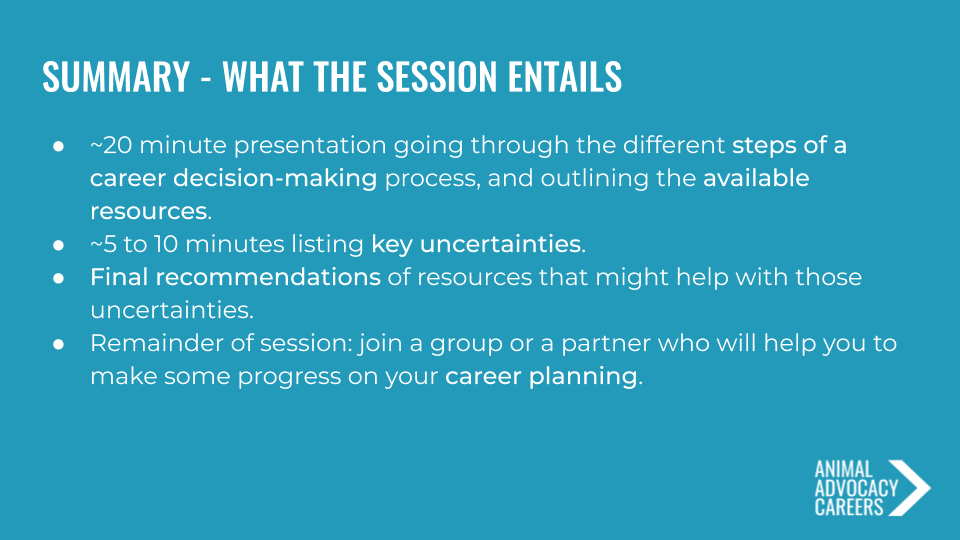
Therefore, for the rest of this session, I'm going to spend about 20 minutes on a presentation that goes through the different steps that are important in an impact-focused process for making career decisions. At each step, I’ll define some key terms and outline some resources that will help you make a decision that maximizes your impact, especially in terms of animal advocacy. [... Throughout this presentation], I’ll refer to an article by 80,000 Hours titled “How to make tough career decisions,” which provides a lot of excellent advice.
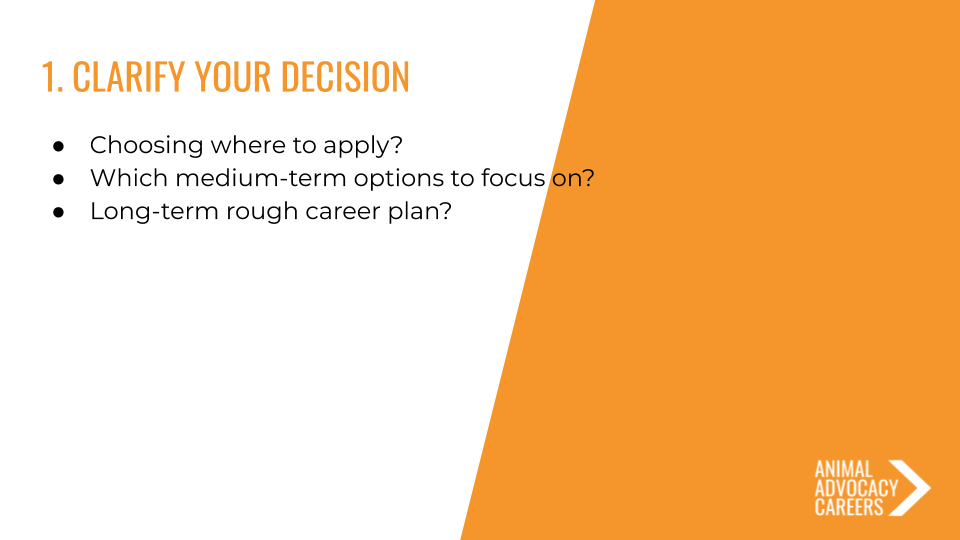
There are many different decisions and career planning processes you could be thinking about, such as where to apply for your next role. You could also be thinking about which medium-term options to focus on, or a longer-term career plan.
I'm going to focus on medium-term planning — [the range that has] the widest applicability. But most of the resources I share will have some relevance to whichever career decisions [interest you].
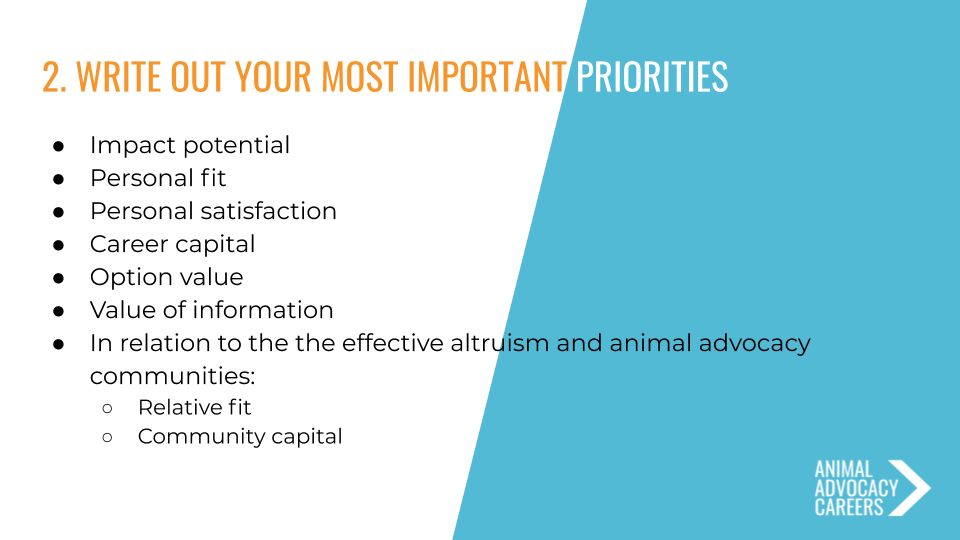
The next step is to write down your most important priorities. If you do this independently, I encourage you to spend some time thinking about it. What it is you're trying to get out of your career, and how important are those different criteria? I'm going to share some that 80,000 Hours [included in the] article I mentioned, and that are widely discussed in the effective altruism community. These are general criteria to consider when you want to maximize your career’s positive impact. I’ll whiz through these, but will delve into each one in a bit, so don't worry if this gets a bit overwhelming, or if you're unfamiliar with the terms:
- Impact potential
- Personal fit
- Personal satisfaction
- Career capital
- Option value
- Value of information
Then there are some considerations [to weigh] in relation to others in the effective altruism and animal activism communities:
- Relative fit
- Comparative advantage
- Community capital
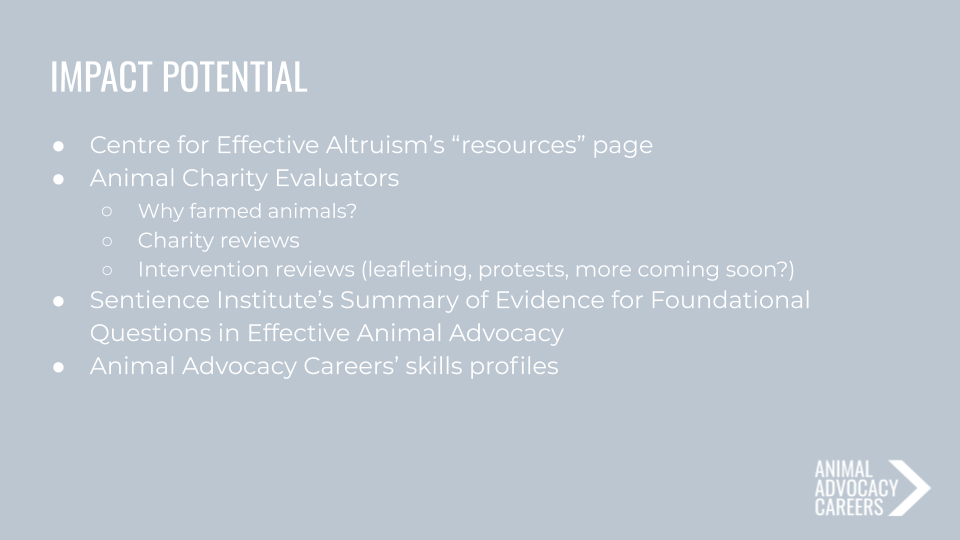
Let’s zoom in on some of these. The first factor to consider, whether you’re ranking options for your next job or making longer-term plans, is impact potential. This is one of the most important factors in terms of evaluating your different options, because some roles could have orders of magnitude more impact than others, just by virtue of the problem that they would allow you to work on and the specific role that you’d fill. This is partly about cause prioritization — comparing different urgent programs that you could work on. For example, [you might explore] animal advocacy compared to global health issues, or long-term threats to humanity's very existence, or cause areas focused on reducing the risk of terrible suffering in the future.
The resources on this are scattered in various places. I think the Centre for Effective Altruism's resources page — you might have heard of it referred to as the EA handbook — is a great place to start. It has a mix of overviews and in-depth articles.
On the issue of cause prioritization, there are several other resources. There's a great and really short introductory resource on this topic: “Why farmed animals?” by Animal Charity Evaluators (ACE), which is partly about broad cause prioritization and partly about comparing farmed animal issues to other animal issues.
Other content is scattered in various places. 80,000 Hours has various problem profiles, many of which are discussed on the EA Forum. For instance, there's a great resource by a colleague of mine at Sentience Institute called “Why I prioritize moral circle expansion over artificial intelligence alignment.” I'd encourage anyone thinking about animal advocacy relative to other longtermist issues to read that.
Also, you can compare different cause areas at a slightly more granular level. For example, you might evaluate sub-causes within animal advocacy, such as farmed animals compared to wild animals, compared to companion animals, and so on. [The resources I’ve mentioned are] a great starting point.
You can then start to compare different intervention types and [gauge which ones] seem more altruistic given the total impact that you could have by working on them. ACE has reviews of charities (evaluating charities is in their name — it’s what they focus on). You can look at the summaries of different evaluations, or go into more depth when considering how these different interventions and sub-causes compare.
ACE also has what they call “intervention reviews.” There are two great reports on leafleting and protests, and hopefully they’ll produce more soon. The organization that I work for, Sentience Institute, has a resource called “The summary of evidence for foundational questions in effective animal advocacy.” I think that's a great starting point for identifying some heuristics for the sorts of actions and interventions that tend to be more, or less, impactful for animals.
Finally, there’s a resource that I’ll mention quite a few times during the rest of this presentation. It's one that I've been working on with Animal Advocacy Careers: our skills profiles. These aggregate some advice and relevant research about particular career types within the advocacy space. They can help you think about whether [your skills might fit well] with certain areas. They’ll give you a general sense of what those career types actually look like. We also provide some content related to the impact that you can have in those roles.
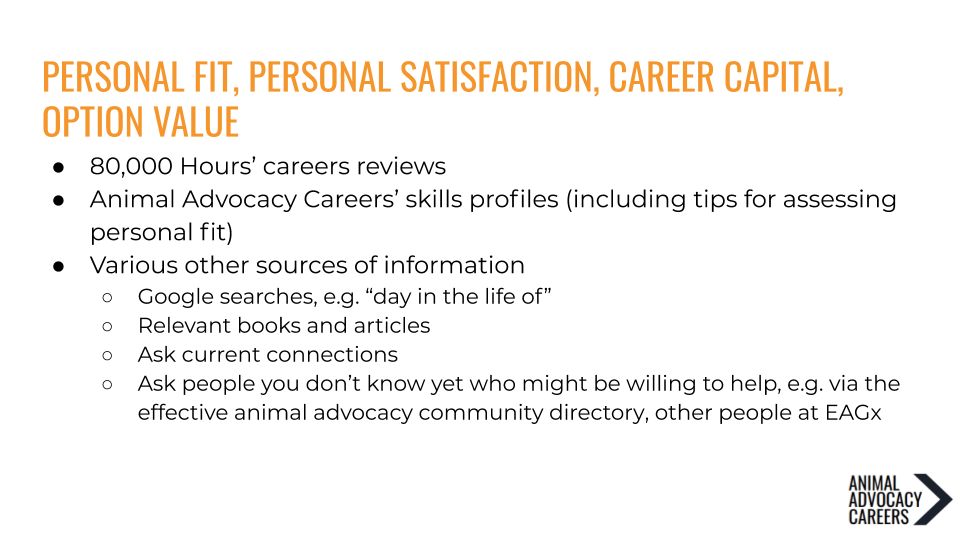
I’ve talked about impact potential. Next, I'm going to cluster a few different considerations, because I think some of the same resources can help you think about personal fit, personal satisfaction, career capital, and option value.
Personal fit [is about] your chances of excelling in different role types. How good will you be in performing the role compared to the average alternative candidate who might fill that role if you don’t?
Personal satisfaction is obviously somewhat related, but it's more about your own personal enjoyment. It relates to personal fit in terms of questions like whether you can sustain your work in the area.
Then there's career capital, which combines several different factors. It's essentially anything that could allow you to excel in other roles: your credentials, the networks that you build, the experience and skills that you accumulate in various roles.
Option value involves preserving backup options. It enables you to pivot out of a role into other roles. That can be highly impactful.
There are some resources to help you address each of these factors. 80,000 Hours has career reviews of roles in areas like academia, management, consultancy, and policymaking. As with the Animal Advocacy Career skills protocols that I already mentioned, 80,000 Hours walks through different career types [to help you determine whether you] have personal fit and how you might fare in the role.
The first three skill profiles are: management and leadership (especially in animal advocacy nonprofits), fundraising, and growing the animal advocacy community in countries where the community is small or new. We also have some forthcoming profiles relating to work in animal-free food technology companies, technical research, and government and policy.
Of course, you can do some information-gathering yourself. You can type “day in the life of …”, followed by the role type you're looking for, into Google. You can look up relevant books and articles. You can ask connections for help. They might be people you already know or some you don't know yet, but who could be willing to help you anyway — especially people within the effective altruism and animal advocacy communities. Those who attended EAGx Virtual are a great example of that; I'm sure you can tap into their knowledge.
Also, there’s a resource called “The effective animal advocacy community directory,” which essentially [lists people who are] happy to chat about various topics. [The list includes a column] indicating whether they're interested in discussing careers. You can quite easily [search the directory by typing] “control F” or “command F” [to find areas of interest], like marketing or plant-based foods. Then, you can fire off a question, meeting request, or connection request.
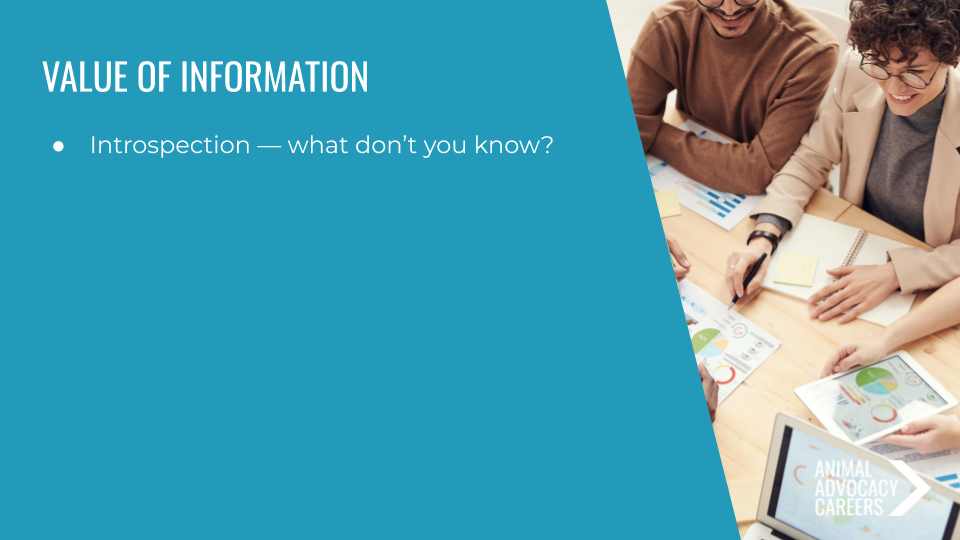
Another factor that you should consider is the value of information. This essentially means whether the role or path that you're considering will help you understand your personal fit with [related] roles and paths. What [might you learn] about other opportunities? This is partly about being introspective and working out what you don't know, although a lot of the resources I've mentioned so far will certainly help.
Other considerations relate to coordination. [At this conference], you're already coordinating with two different communities: the effective altruism community and the animal advocacy or animal rights community. They partly overlap, but are also somewhat separate.
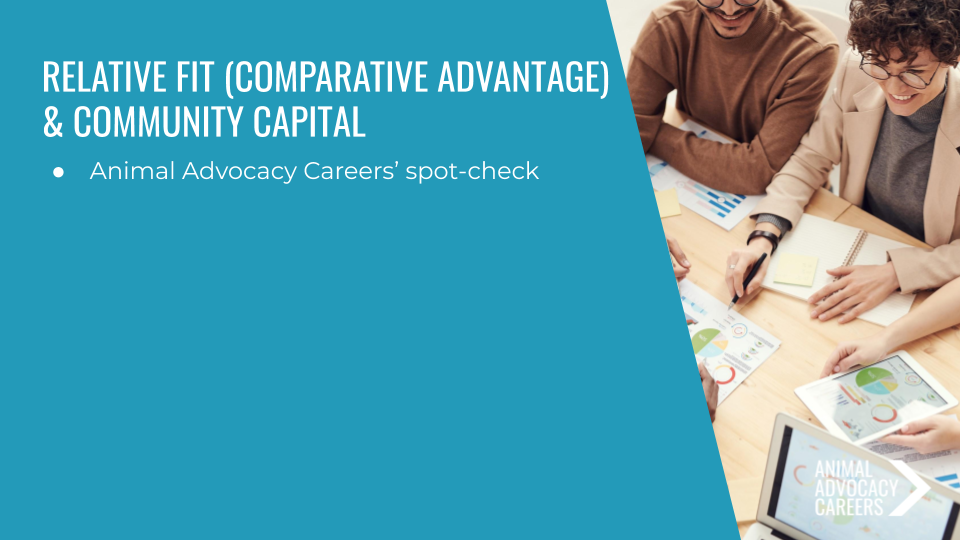
Relative fit or comparative advantage, as opposed to personal fit, is how you compare to the average candidate for a particular role type. This [consideration can help you find] the job that has the highest expected impact for you once you account for the possibility of coordinating with other groups. It's about how your strengths compare to those of other community members. [Transcriber’s note: for example, a movement might try to work out how to distribute advocates between positions so that they have a higher collective impact.]
Community capital is about whether a role type would increase the influence, power, and knowledge of the community. There are some resources relevant to this.
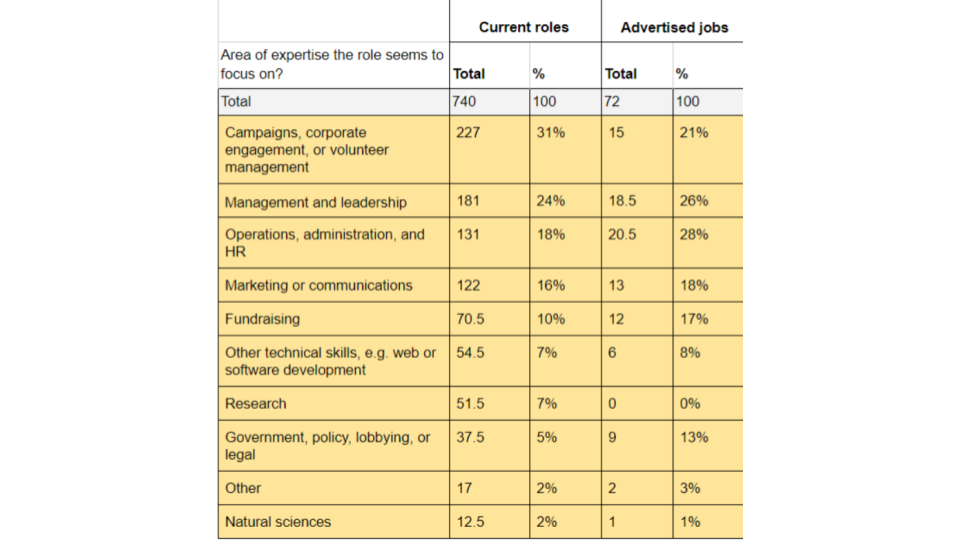
For example, Animal Advocacy Careers’ spot-check research compiles a list of 27 different effective animal advocacy nonprofits. We looked at their currently filled roles and the job advertisements that they had posted at any given point. The logic here is that if certain types of expertise are under-supplied in the community relative to the needs of the community, we would expect that those skill sets would be overrepresented in animal advocacy job advertisements, because it would be harder to fill those roles.
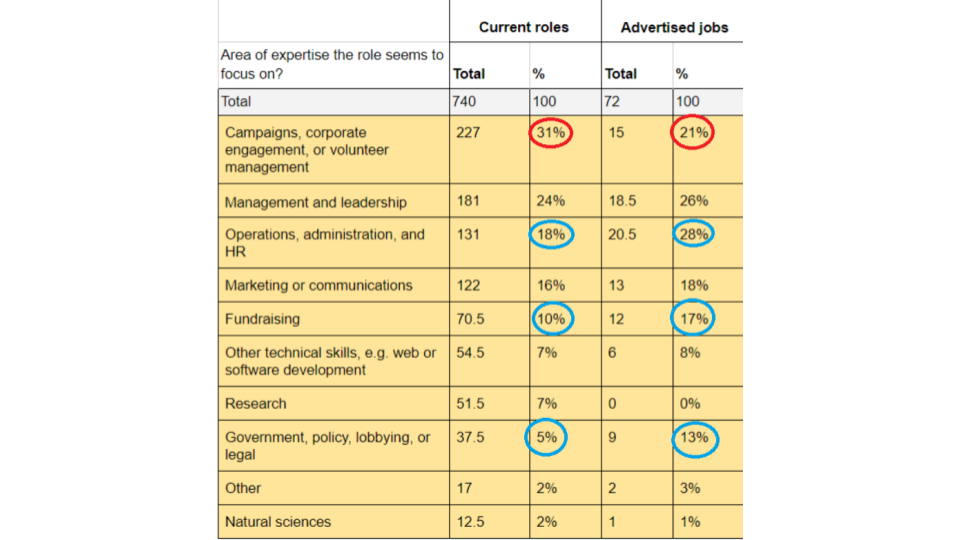
Here's an example of one of the tables from the spot-check. Ignore the “total” column and focus on the “percentages” columns. Let's look at the ones in blue first. You can see on the right-hand side the advertised jobs. For those circled in blue, there's a higher proportion of advertised jobs of particular role types than for the currently filled roles. Again, this suggests that nonprofits are struggling to hire for those role types. You can see that fundraising, lobbying, and operations roles are all somewhat difficult to fill. In contrast, campaigning roles don’t seem to have that problem. Current roles are actually overrepresented relative to advertised roles. And for other role types, there is less of a clear difference.
You can zoom in on some of the details of the spot-check research. There are various limitations. I'm sure some of you are thinking, “I can see a lot of flaws in that.” Yes, there are flaws. It provides what I call “weak evidence” for a number of different issues and questions.
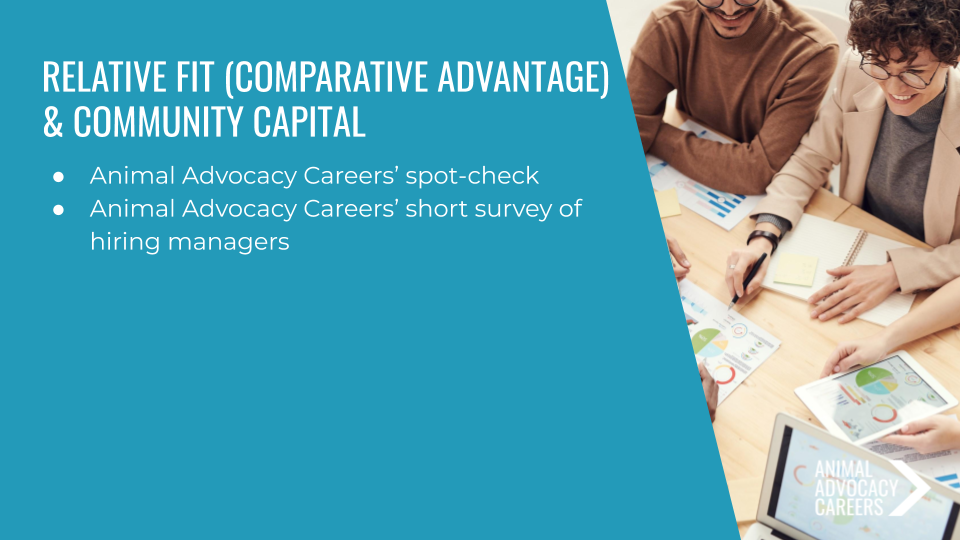
Another piece of imperfect research we did was a [2019] survey with a small number of CEOs and hiring managers at some of the same kinds of nonprofits we included in the spot-check research. Most of them were standout charities recommended by Animal Charity Evaluators.
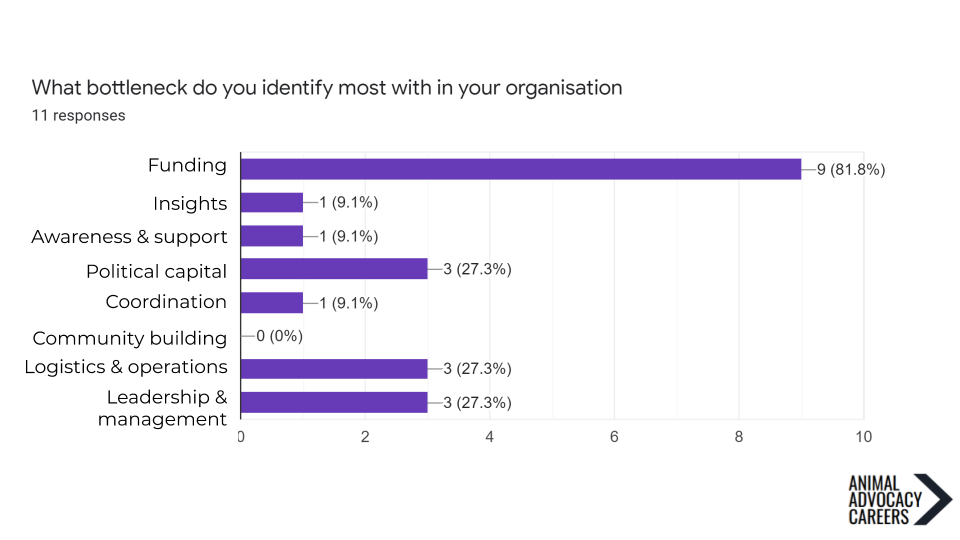
[Above] is an example of one of the findings. We asked, “What bottleneck do you identify most with in your organization?” The most common response by far was funding, with 82% of the respondents — nine out of twelve — selecting it. This gives us insight into a number of different questions. Some of the evidence overlaps with the spot-check research; for example, there are quite a lot of people [who appear to have] difficulty hiring fundraisers. Some evidence did not overlap; for example, in the survey, there were many references to struggling to hire senior people or managers, but that didn't come up as much in the spot-check research. I encourage you to look at this research in more detail if it seems helpful for thinking about your comparative advantage.
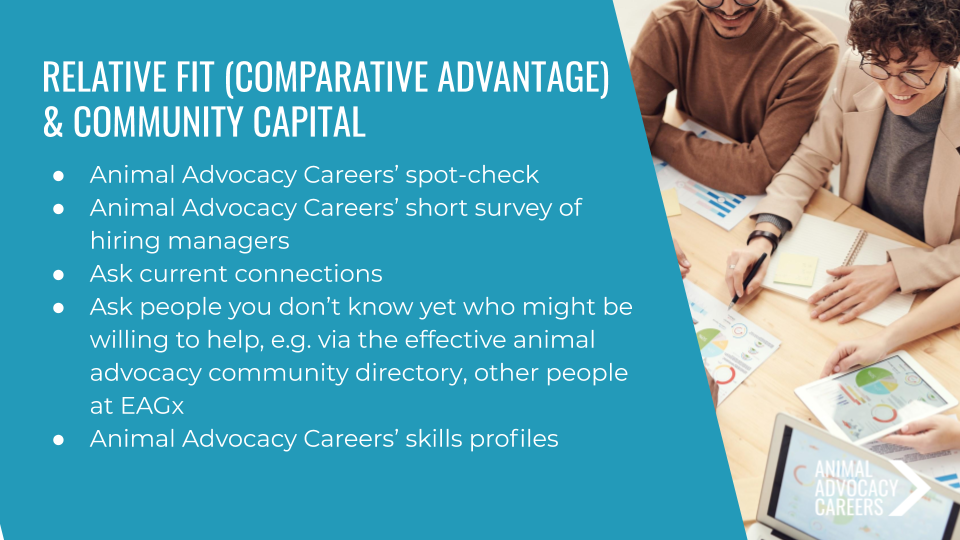
Again, you can ask current connections about how you might fit in, and to get a sense of what the community looks like and what the talents of people in the community are. And you can ask people you don't know yet via the effective animal advocacy community directory. By the way, the best place to access the community directory is via the Effective Animal Advocacy Discussion Facebook group. [...]
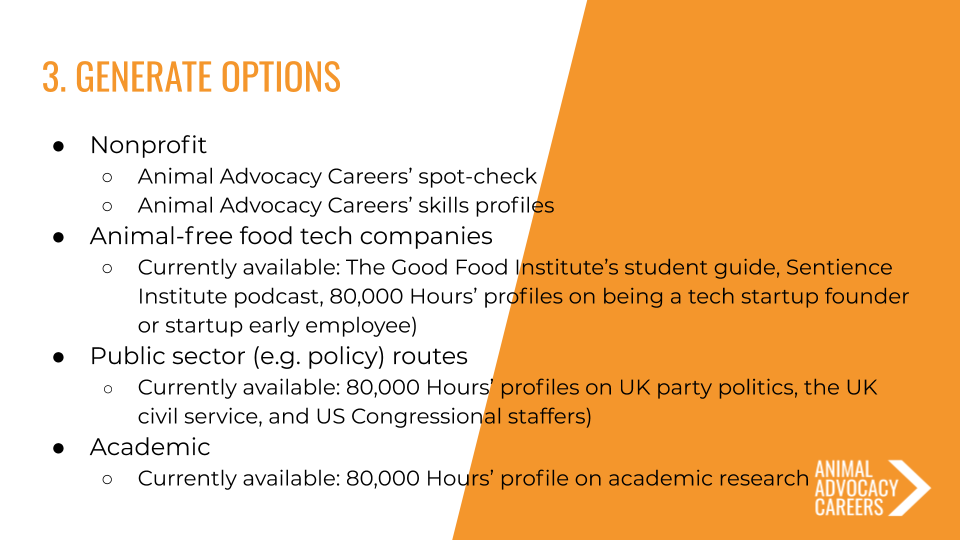
So far, I've mostly covered some different factors to consider when evaluating your options — whether you’re doing so for your next job, or formulating medium- or long-term career plans. The third step is to generate some actual options.
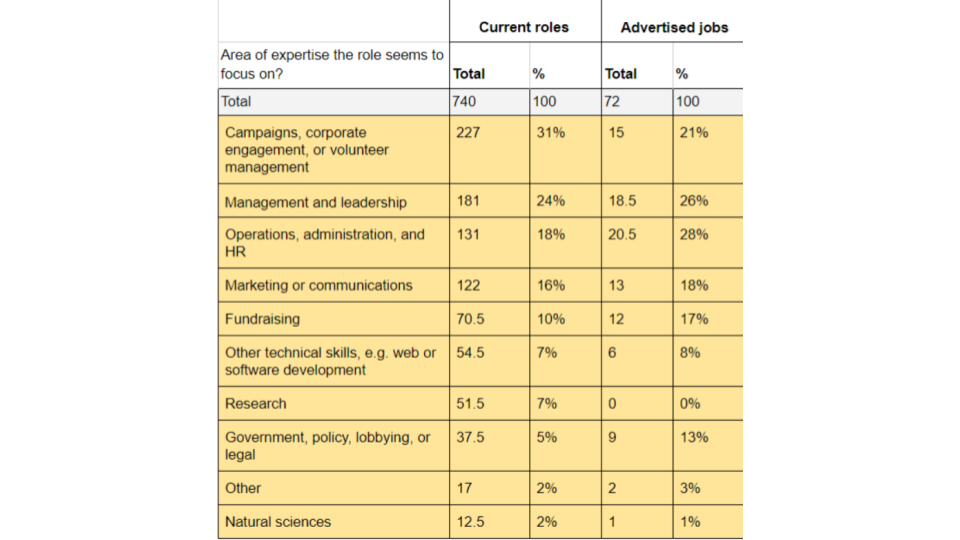
I've talked a lot about nonprofit roles, especially with reference to the spot-check research that I did and the skills profiles that we've worked on at Animal Advocate Careers. But I also want to emphasize that these are not the only high-impact opportunities available to animal advocates. You should also consider working in animal-free food tech. Some companies in this area grow meat products from animal cells without requiring the slaughter of animals; others produce plant-based foods. Examples include Impossible Burger and Beyond Burger, whose products could displace animal products.
We do have another spot-check resource [in the pipeline] on technical research in animal-free food tech companies. In the meantime, there are some great resources from the Good Food Institute (GFI), which is one of the main nonprofits working in this area. They have a student guide, which I think is probably helpful for people who aren’t students as well. It lists different career types. I also conducted an interview for Sentience Institute with [Elliot Swartz] from GFI. We go into detail on these different career options. 80,000 Hours also has some content related to this in their careers reviews.
You should also consider public-sector roles (i.e. roles in policy and politics). I have a skills profile coming out that combines some of these different options. 80,000 Hours has more in-depth content on these kinds of roles, although it isn’t specific to animal advocacy. But their resources cover some different roles, such as US congressional staffers and roles in UK party politics and the UK civil service, AI policy, think tank research, and academic research. This is all to say that in generating options, [there’s value in] looking through existing lists of roles.
Before I move on, it's important not to focus on too narrow a set of options. This is a common mistake. It's very important to consider at least three. Don't stick with two. Don't discard options prematurely.
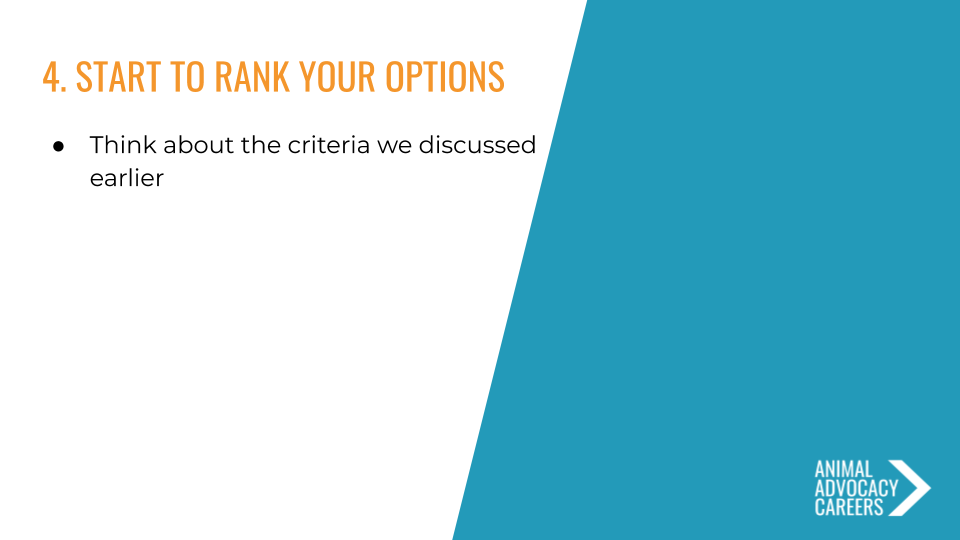
That said, you do need to narrow down and rank your options. Ask yourself: If everything works out well, what, potentially, are the highest-impact options? That's what you're looking for, especially if you're early in your career.
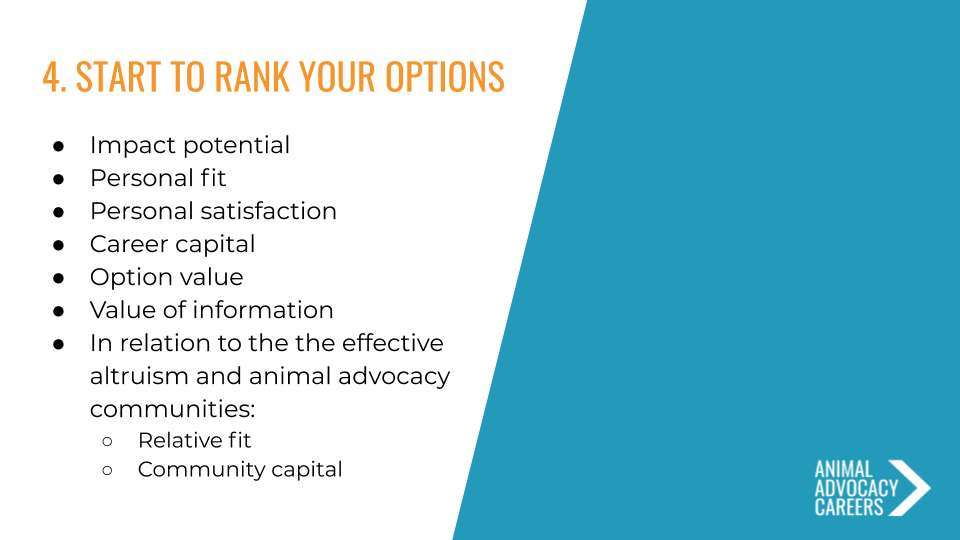
Let me briefly run through the criteria we discussed earlier: impact potential, personal fit, personal satisfaction, career capital, option value, value of information, relative fit or comparative advantage, and community capital. Thoroughly understanding and weighing all of those different considerations takes a lot of time, as well as some research. Obviously, we're not going to be able to complete that in this session.
But one thing that is important is to rank those considerations. Start working out what your key uncertainties are, and what you’ll need to find out more about in order to make progress on your ranking. What information is the most likely to change your ranking?
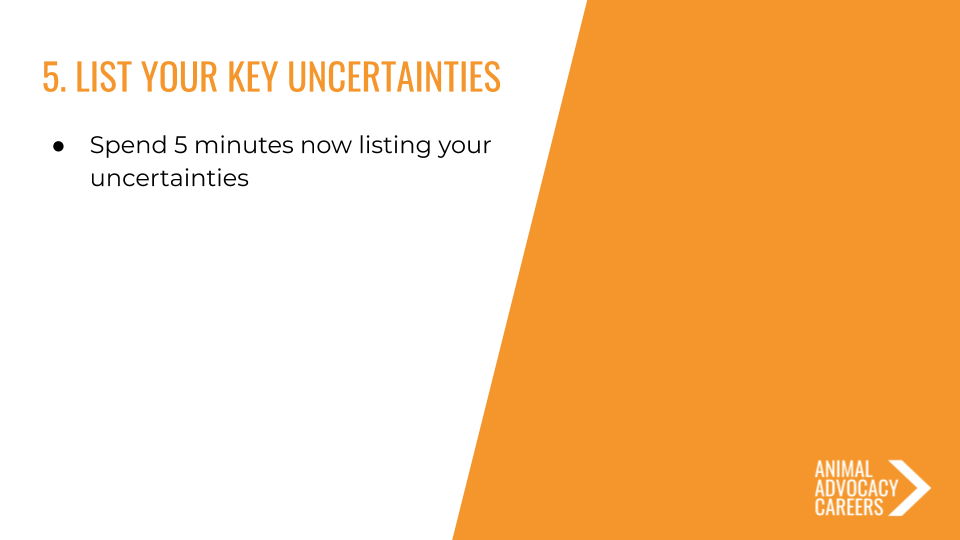
I want to spend five minutes writing down those uncertainties now. It will help make the rest of the session more useful.
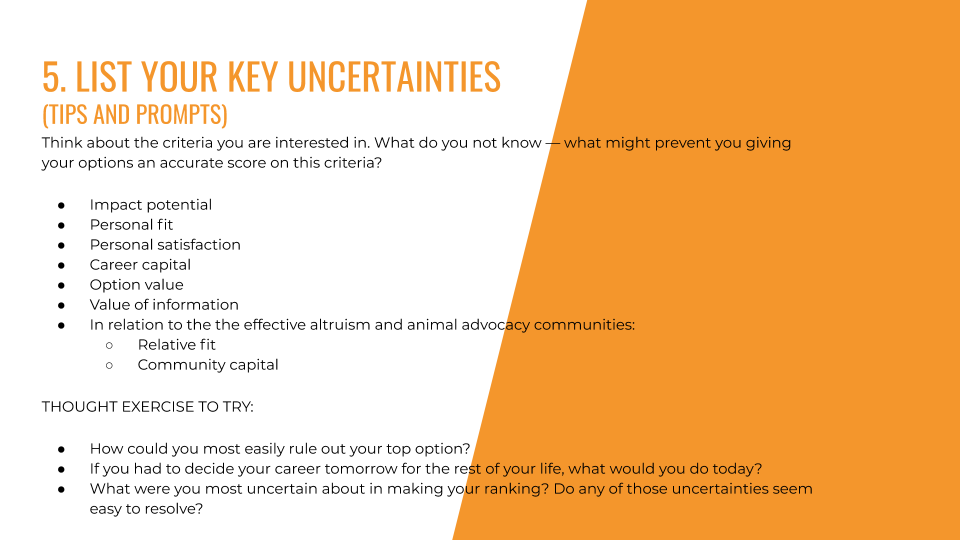
I'm going to put some prompts up, but feel free to approach this in a free-form way and just crack on. If you’ve already done this recently, then you might like to instead think about whether you’ve made progress on addressing your areas of uncertainty so far at EAGx — and what else you could do to address them. What information could you gather? And if you're thinking, “This is too far of a leap for me — I'm not ready to think about what my uncertainties are, and I still need to generate options,” then that's fine. You can just spend the next five minutes generating some options instead.
I’m going to put some prompts up on [a slide]. Don’t feel obligated to use them; they’re just there if you’re struggling. I’ll shut up now and let you crack on.
[Five-minute pause]
Hopefully you've had a chance to list some of your uncertainties.
The next thing I'm going to do is put up [a slide with] some of the resources I've been talking about so far in this presentation. Most should be familiar; I'll explain the additional ones.
Once the list is up, pick one or two resources that you want to prioritize looking into. I'd encourage you to not just pick them, but actually select a time in your calendar to review them, or place them on your to-do list so that you take action to make further progress on your career decision-making process (instead of letting this presentation just fade into the background).
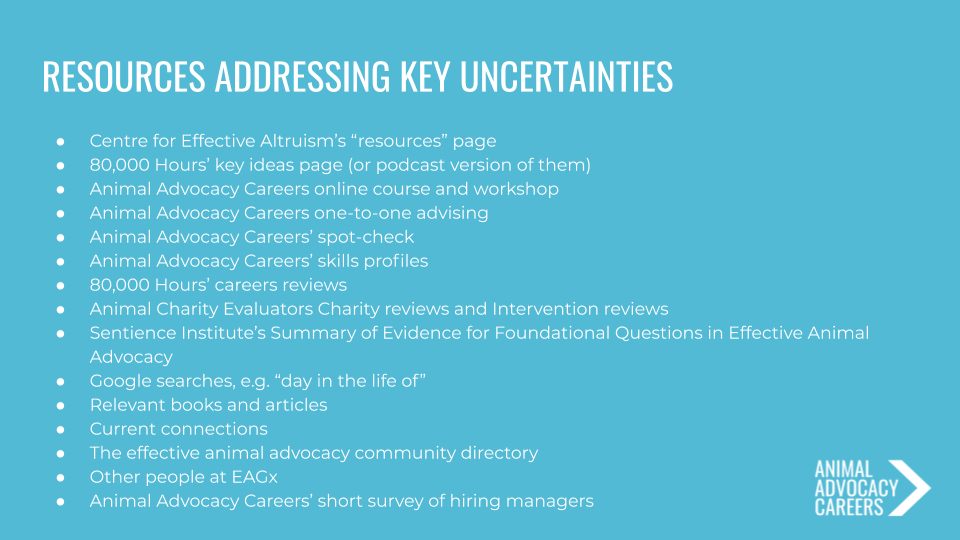
One of the only ones that I didn't mention is 80,000 Hours' key ideas page. There's a podcast version as well. It goes through some of the considerations that we've been talking about, like career capital and personal fit, in more depth — and they provide links to other resources. That could be great if you're fairly new to thinking about these impact-focused career decisions, and everything else here makes you feel like you're launching into the deep end.
Another resource that could be really helpful is Animal Advocacy Careers’ forthcoming online course and workshop. This is intended to be a one-to-one [program] to help people go through strategic considerations for effective animal advocacy. It draws on the foundational questions and summaries that I've been talking about from Sentience Institute and various other animal advocacy research organizations, as well as career considerations from groups like 80,000 Hours and our own research. It culminates in a workshop, where you can spend more time on the planning process and addressing your uncertainties. Hopefully, it’s a useful process for going through all of the steps if you're fairly new to [animal advocacy].
If you're already quite familiar with these sorts of considerations, another thing that we can offer is our one-to-one advising program. This is essentially a call with me. You can submit an application, and we’ll talk through some of the factors and different options that you’re considering. I’ll help you rank them, think about comparative advantage, and that sort of thing.
[...]
Thank you very much for joining. Go forth and make some more progress on your key uncertainties! Thanks again.
